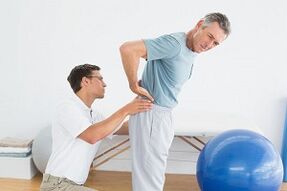
The lumbar spine is the most sensitive to stress, as it is affected by the entire body weight. In addition, it is very mobile.
If the spinal corset is not sufficiently developed, the pressure on the intervertebral discs increases several times. Namely, they are responsible for the mobility and flexibility of the back.
Osteochondrosis of the lower back, which occurs for various reasons, is a fairly common disease of the musculoskeletal system.
It develops gradually, and a person may simply not pay attention to its first signs. However, it requires serious treatment.
How the disease develops and its causes
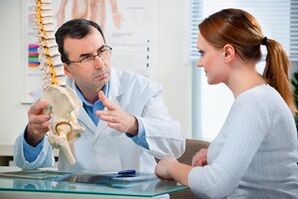
In the lower back, the sacrum and thoracic vertebra are connected. There are many factors causing lumbar osteochondrosis. The main thing is considered to be an incorrect and excessive load on the back.
During the disease process, glycoproteins are broken down, affecting the connective tissue of the joints and making it elastic. It affects the bone and cartilage structures of the spine.
Intervertebral discs contain a gel-like substance that dries up with low back disease. They are exhausted, then they go flat. Due to this, the spine loses its cushioning function, its segments come together, and the nerve roots and blood vessels are constricted.
At the same time, the fibrous ring cracks, and in some cases it can rupture, which leads to the formation of a hernia. All this causes swelling, lower back pain.
The muscular framework protects the spine from negative influences and is responsible for good posture. Problems with it can also lead to the development of osteochondrosis of the lumbar spine.
There are other reasons for the onset of the disease:
- Congenital changes, loose disc structure.
- Stressful state.
- Infectious diseases of bone and cartilage tissue.
- Inconvenient shoes.
- Back injury.
- Inflammation of the joints.
Lifestyle, profession, age are also important here. The maximum load on the spine occurs while sitting. Therefore, people who spend most of their time sitting are at risk.
These can be office workers, drivers. Low physical activity is also not the best way to affect the lumbar spine. As a result, the musculoskeletal system weakens.
An important role is played by the influence on the spine, and in particular the lower back, bodybuilding. This is due to such occupations as a loader, construction worker, waiter or professional athlete, that is, people with constant back stress.
Osteochondrosis can also occur during pregnancy in women. If there is a curvature of the spine, then increased pressure on the lumbar spine and uneven weight distribution also leads to disease.
Likewise, it affects the occurrence of osteochondrosis and flat feet. The arch of the foot loses its function and all the load when walking goes to the spine. Being overweight also plays a negative role. The disease can be a complication after osteomyelitis, tuberculosis.
Adverse factors of lumbar osteochondrosis are also improper sleeping habits, nutrition, disturbed metabolic processes in the body or diseases of internal organs:
- gastrointestinal tract and liver;
- small basin;
- central nervous system.
People of different ages are susceptible to the disease.
Symptoms of lumbar osteochondrosis

One of the first manifestations is usually pain and discomfort in the lumbar spine. At the same time, it can be difficult to bend, turn, bend the big toe. Sometimes there is a feeling of cold or, conversely, a burning sensation in the back.
As a rule, symptoms appear after physical exertion, hypothermia or an awkward position for a long time. They often leave after a short rest. In the acute phase, they can have the character of lumbago and are aggravated by movements, coughing, sneezing.
Muscle spasms in the back do not allow a person to take a position, which will lead to increased pain, this happens reflexively. In addition to these symptoms, there are the following signs:
- Fatigue and weakness.
- Increased sweating.
- Sleep disturbances.
- Varicose veins.
- Tingling sensation and pain in the limbs.
- Violation of tendon reflexes.
Due to spasms, the legs may freeze, as well as beak-like growth and a decrease in the height of the discs.
The sciatic nerve, which is formed by the sacred roots of the spinal cord, can also suffer from osteochondrosis of the lower back. This is manifested by pain that radiates down the leg or swelling.
If the arteries or vessels are compressed, this is characterized by loss of sensitivity, but the pain is mild. They are localized in the lower back, meet in the hips, buttocks. The pain syndrome also differs in the time of its onset. Painful sensations usually appear in the morning, over time they can become permanent and not depend on movement.
Complications of osteochondrosis of the lumbar spine
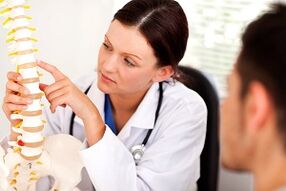
The instability of the discs and the fact that they do not fix the spine lead to displacement of the lumbar spine. It also affects the work of internal organs. Osteochondrosis is complicated by problems with the genitourinary system, a feeling of discomfort in the kidneys.
In women, menstrual irregularities are possible with, in men, problems in the genital area. Another symptom of the disease is scaly, dry skin in the affected areas.
If you do not treat osteochondrosis treatment, it can lead to stroke and other unpleasant consequences. Protrusion of the discs is possible when they stretch and go beyond the limits of the vertebrae. Cartilage atrophy also manifests itself. During this time, the pain may subside due to the growth of bone tissue.
Spondylarthrosis is sometimes isolated as a form of osteochondrosis, but more often it is seen as a complication of it. With it, growths in the form of bony spikes are formed on the spine. They are localized, the pain is present in the lumbar region and does not spread to other parts of the body.
Another consequence is paresis of the foot. In the lower back, unpleasant sensations appear, spreading to the area below the knee and further, which causes the ankle joint to malfunction. All of these can contribute to disability.
Diagnosis of osteochondrosis of the lumbar spine
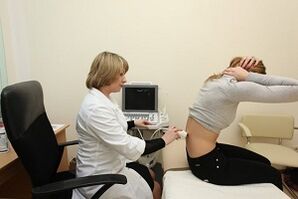
There are several types of studies that a doctor can order for symptoms of lumbar osteochondrosis:
- Plain x-ray (spondylography), which shows the condition of each vertebra separately, intervertebral discs, and bone canals.
- Myelography is a more complex type of diagnosis. To achieve this, a coloring liquid is injected into the spinal canal. It helps to find spinal hernias.
- A similar procedure is discography, but with it fluid is injected into the spinal disc.
- Pneumomyelography. Here, air is used instead of liquid.
Computed tomography can detect compression of nerve roots, rupture of the contour of the disc. For more severe cases, an MRI may be ordered.
Methods of treatment of diseases

The main thing is to see a doctor in time and take the treatment seriously. For recovery, you need to make an effort and avoid relapses to engage in prevention. Lumbar therapy is a comprehensive approach. The aim here is not only to stop the development of the disease and alleviate the symptoms, but also to put the spine back in the right position.
The specialist usually prescribes drugs using analgesics and anti-inflammatory drugs: NSAIDs, analgesics. Muscle relaxants are also used. They aim to eliminate spasms and discomfort resulting from increased muscle tone.
Vasodilator drugs prevent congestion and improve blood circulation. Vitamins and minerals strengthen bones, ligaments, and tendons and help remove fluids from the body. They are often prescribed for the elderly.
Chondroprotectors are also used for treatment, which stop destructive processes in cartilage tissue and help regeneration. The drugs are administered orally, by injection or rectally.
Paravertebral blocks are used for quick pain relief when the medicine is injected into the affected area. But doctors try not to use them often. The body gradually gets used to it and the effectiveness of the impact decreases. In addition, if there is a blockage, the muscles may atrophy where the drug is injected.
The treatment complex also includes exercise therapy. It improves the mobility of the spine and strengthens its muscles. Therapeutic exercises should be selected by a specialist, they are often prescribed after relief from an acute condition. The load is increased gradually so as not to provoke an exacerbation. In addition, gymnastics is used if the patient has worn a corset for a long time.
An important part of the treatment is massage. It aims to relax, relieve pain and spasms. The procedure reduces muscle stiffness and has a good effect on lymphatic circulation in the tissues around the lumbar region.
Physiotherapeutic treatment methods are also used. To achieve the desired effect, they must be carried out regularly. Exposure to ultraviolet rays, eliminates spasms, pain affects blood circulation. Laser therapy improves the condition of the spinal roots due to the influence of helium-neon emitters. Stretching of the spine is also used, as well as the following methods:
- amplipulse;
- phonophoresis;
- diadynamic currents.
However, physiotherapy also has contraindications - these are oncological diseases, diseases of the central nervous system. The main task of all these measures is to bring the lumbar spine back to the correct anatomical position. As a rule, the course lasts on average 2-3 months, but it all depends on the particular case.
Operations for osteochondrosis of the lower back

Usually, surgery is used for complications, such as a hernia. A discectomy is performed, that is, the damaged disc is removed. Microsurgery and endoscopy are less traumatic for the patient and the risk of complications is minimal.
During such an intervention, special small-diameter tube expanders are used. Because of this, the muscles and ligaments are not damaged. On average, the procedure takes about an hour.
The rehabilitation period takes less time than after a disctomy. But here the assistance of the patient is important, who must strictly follow all the prescriptions of the neurosurgeon.
Additional treatment and prevention measures
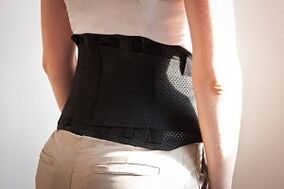
Correcting lifestyle and habits is the first step in the treatment of osteochondrosis of the lumbar spine. Rest and a gentle diet are important in therapy. It is better to equip the bed with an orthopedic mattress and a pillow, it is good to put a special roller under the neck. Avoid being in the same position for a long time, hypothermia. It is undesirable to stand up suddenly.
Sometimes a special fixation corset is recommended. It keeps your back in the right position, but not all experts approve of its long-term wearing. This can lead to muscle atrophy of the spine. Most often it is used during an exacerbation of the disease. Models of corsets are not universal, and in any case, only a doctor should select an accessory.
Along with treatment, it is important to follow a number of measures that a doctor may recommend. It is the normalization of weight, good nutrition is useful here. It is better to eliminate heavy and fatty foods from the diet or reduce its consumption.
It is advisable for osteochondrosis of the lumbar spine to refuse such products:
- Soft drinks.
- Salt and sugar.
- Coffee and spices.
- Alcohol.
It is good to introduce in the diet: sea fish, vegetable oils, dairy products, vegetables, fruits and herbs. Jelly meat, jelly, which includes gelatin, will be useful. It is best to steam food.
Walking and swimming are also good for the spine, it will be useful to monitor your posture. These are necessary measures after the end of treatment in order to prevent the recurrence of osteochondrosis.
Folk remedies and alternative methods
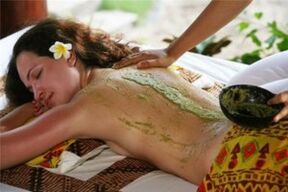
Ointments, compresses are made from plant materials to relieve pain and inflammation. Often used to grind red pepper tincture. Liquid ointment can be made from mustard powder, camphor alcohol, and egg whites. It is applied at night.
They make compresses with honey and aloe or cabbage leaves, to use for this and a decoction of burdock leaves Baths with needles are useful.
There are also alternative treatment options:
- hirudotherapy (use of leeches);
- manual and vacuum therapy;
- acupuncture.
All these funds are best used after consultation with the attending physician.
Self-medication or ignoring the symptoms of osteochondrosis of the lumbar spine can lead to more serious diseases of the spine. Therefore, you should not start a disease, because the earlier you start treatment, the faster and easier it will be to resolve the problem.























